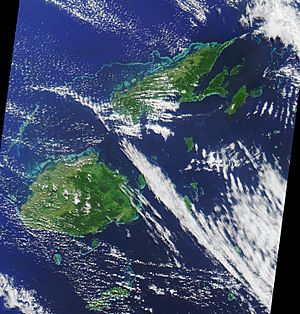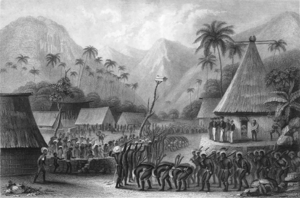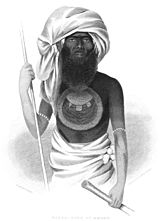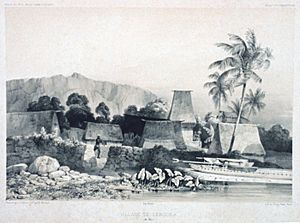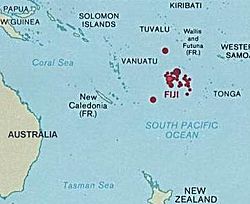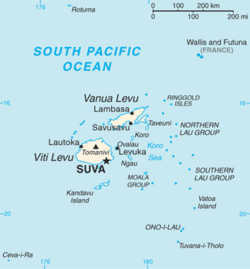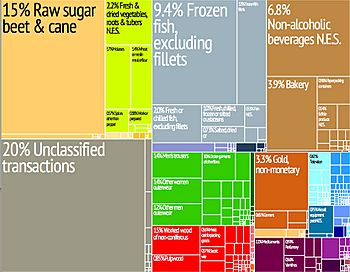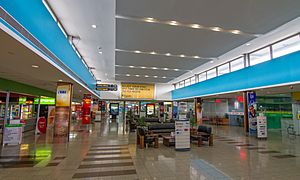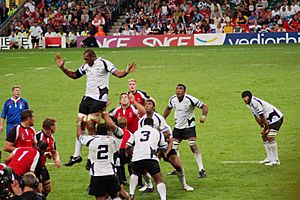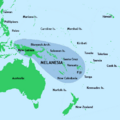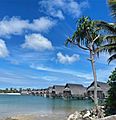Fiji facts for kids
Quick facts for kids
Republic of Fiji
|
|
|---|---|
|
Motto: "Rerevaka na Kalou ka Doka na Tui" (Fijian)
"Fear God and honour the King" |
|
|
Anthem: "God Bless Fiji"
|
|
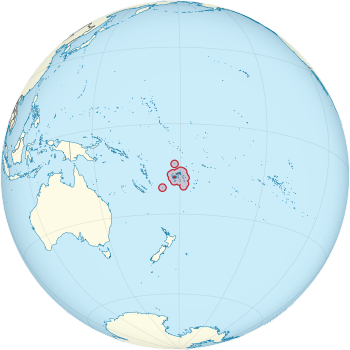 |
|
| Capital and largest city
|
Suva 18°10′S 178°27′E / 18.167°S 178.450°E |
| Official languages | |
| Recognised regional languages | Rotuman |
| Ethnic groups
(2016)
|
|
| Religion |
|
| Demonym(s) | Fijian |
| Government | Unitary parliamentary republic |
| Naiqama Lalabalavu | |
| Sitiveni Rabuka | |
|
• Chief Justice
|
Salesi Temo (acting) |
| Legislature | Parliament |
| Independence
from the United Kingdom
|
|
|
• Independence
|
10 October 1970 |
|
• Republic
|
6 October 1987 |
|
• Current constitution
|
6 September 2013 |
| Area | |
|
• Total
|
18,274 km2 (7,056 sq mi) (151st) |
|
• Water (%)
|
negligible |
| Population | |
|
• 2018 estimate
|
926,276 (161st) |
|
• 2017 census
|
884,887 |
|
• Density
|
46.4/km2 (120.2/sq mi) (148th) |
| GDP (PPP) | 2023 estimate |
|
• Total
|
|
|
• Per capita
|
|
| GDP (nominal) | 2023 estimate |
|
• Total
|
|
|
• Per capita
|
|
| Gini (2019) | ▼ 30.7 medium |
| HDI (2022) | high · 104th |
| Currency | Fijian dollar (FJD) |
| Time zone | UTC+12 (FJT) |
| Date format | dd/mm/yyyy |
| Driving side | left |
| Calling code | +679 |
| ISO 3166 code | FJ |
| Internet TLD | .fj |
|
Website
fiji.gov.fj |
|
Fiji is a small country in the Pacific Ocean. It has 322 islands. The most important islands are Vanua Levu and Viti Levu. The capital city of Fiji is Suva, and the city with the most people is Nadi. There are about 844,330 people in Fiji. The official languages of Fiji are Fijian, English and Hindustani (a mix of Hindi and Urdu). Fiji is part of the Pacific Rim. About 313000 speak Fiji Hindi.
In the 17th and 18th centuries, the Dutch and the British explored Fiji. Fiji was a British colony up until 1970; British occupation lasted almost a century. They have many forest, mineral, and fish resources.
Contents
History
Early history
Pottery art from Fijian towns shows that Fiji was settled before or around 3500 to 1000 BC, although the question of Pacific migration still lingers. It is believed that the Lapita people or the ancestors of the Polynesians settled the islands first but not much is known of what became of them after the Melanesians arrived; they may have had some influence on the new culture, and archaeological evidence shows that they would have then moved on to Samoa, Tonga and even Hawai'i.
The first settlements in Fiji were started by voyaging traders and settlers from the west about 5000 years ago. Lapita pottery shards have been found at numerous excavations around the country. Aspects of Fijian culture are similar to the Melanesian culture of the western Pacific but have a stronger connection to the older Polynesian cultures. Trade between Fiji and neighbouring archipelagos long before European contact is testified by the canoes made from native Fijian trees found in Tonga and Tongan words being part of the language of the Lau group of islands. Pots made in Fiji have been found in Samoa and even the Marquesas Islands.
Across 1,000 kilometres (620 mi) from east to west, Fiji has been a nation of many languages. Fiji's history was one of settlement but also of mobility.
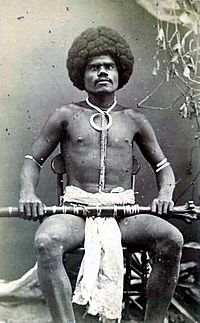
The Dutch explorer Abel Tasman visited Fiji in 1643 while looking for the Great Southern Continent. Europeans settled on the islands permanently beginning in the 19th century. The first European settlers to Fiji were beachcombers, missionaries, whalers, and those engaged in the then booming sandalwood and bêche-de-mer trade.
Ratu Seru Epenisa Cakobau was a Fijian chief and warlord from the island of Bau, off the eastern coast of Viti Levu, who united part of Fiji's warring tribes under his leadership. He then styled himself as Tui Viti or King of Fiji, and then Vunivalu, or Protector, after the cession of Fiji to the United Kingdom.
The British subjugated the islands as a colony in 1874, and the British brought over Indian contract labourers to work on the sugar plantations as the first governor of Fiji, Arthur Charles Hamilton-Gordon, adopted a policy disallowing the use of native labour or any interference in their culture or way of life. In 1875–76, an epidemic of measles killed over 40,000 Fijians, about one-third of the Fijian population. The population in 1942 was approximately 210,000 of whom 94,000 were Indians, 102,000 native Fijians, 2,000 Chinese and 5,000 Europeans.
Independence (1970)
The British granted Fiji independence in 1970. Democratic rule was interrupted by two military coups in 1987 precipitated by a growing perception that the government was dominated by the Indo-Fijian (Indian) community. The second 1987 coup saw both the Fijian monarchy and the Governor General replaced by a non-executive president and the name of the country changed from Dominion of Fiji to Republic of Fiji and then in 1997 to Republic of the Fiji Islands. The two coups and the accompanying civil unrest contributed to heavy Indo-Fijian emigration; the resulting population loss resulted in economic difficulties and ensured that Melanesians became the majority.
In 1990, the new constitution institutionalised ethnic Fijian domination of the political system. The Group Against Racial Discrimination (GARD) was formed to oppose the unilaterally imposed constitution and to restore the 1970 constitution. In 1992 Sitiveni Rabuka, the Lieutenant Colonel who had carried out the 1987 coup, became Prime Minister following elections held under the new constitution.
The year 2000 brought along another coup, instigated by George Speight, which effectively toppled the government of Mahendra Chaudhry, who in 1997 had become the country's first Indo-Fijian Prime Minister following the adoption of the new constitution.
In 2005, the Qarase government amid much controversy proposed a Reconciliation and Unity Commission with power to recommend compensation for victims of the 2000 coup and amnesty for its perpetrators. However, the military, especially the nation's top military commander, Frank Bainimarama, strongly opposed this bill. Bainimarama agreed with detractors who said that to grant amnesty to supporters of the present government who had played a role in the violent coup was a sham. His attack on the legislation, which continued unremittingly throughout May and into June and July, further strained his already tense relationship with the government.
In late November and early December 2006, Bainimarama was instrumental in the 2006 Fijian coup d'état. Bainimarama handed down a list of demands to Qarase after a bill was put forward to parliament, part of which would have offered pardons to participants in the 2000 coup attempt. He gave Qarase an ultimatum date of 4 December to accede to these demands or to resign from his post. Qarase adamantly refused either to concede or resign, and on 5 December the president, Ratu Josefa Iloilo, was said to have signed a legal order dissolving the parliament after meeting with Bainimarama.
In April 2009, the Fiji Court of Appeal ruled that the 2006 coup had been illegal. This began the 2009 Fijian constitutional crisis. President Iloilo abrogated the constitution, removed all office holders under the constitution including all judges and the governor of the Central Bank. He then reappointed Bainimarama as prime minister under his "New Order" and imposed a "Public Emergency Regulation" limiting internal travel and allowing press censorship.
For a country of its size, Fiji has fairly large armed forces, and has been a major contributor to UN peacekeeping missions in various parts of the world. In addition, a significant number of former military personnel have served in the lucrative security sector in Iraq following the 2003 US-led invasion.
Geography
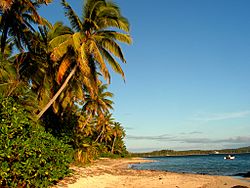
Fiji covers a total area of some 194,000 square kilometres (75,000 sq mi) of which around 10% is land.
Fiji is the hub of the South West Pacific, midway between Vanuatu and Tonga. The archipelago is located between 176° 53′ east and 178° 12′ west. The 180° meridian runs through Taveuni but the International Date Line is bent to give uniform time (UTC+12) to all of the Fiji group. With the exception of Rotuma, the Fiji group lies between 15° 42′ and 20° 02′ south. Rotuma is located 220 nautical miles (410 km; 250 mi) north of the group, 360 nautical miles (670 km; 410 mi) from Suva, 12° 30′ south of the equator.
Fiji consists of 332 islands (of which 106 are inhabited) and 522 smaller islets. The two most important islands are Viti Levu and Vanua Levu, which account for about three-quarters of the total land area of the country. The islands are mountainous, with peaks up to 1,324 metres (4,341 ft), and covered with thick tropical forests.
The highest point is Mount Tomanivi on Viti Levu. Viti Levu hosts the capital city of Suva, and is home to nearly three-quarters of the population. Other important towns include Nadi (the location of the international airport), and Lautoka, Fiji's second city with large sugar cane mills and a seaport.
The main towns on Vanua Levu are Labasa and Savusavu. Other islands and island groups include Taveuni and Kadavu (the third and fourth largest islands, respectively), the Mamanuca Group (just off Nadi) and Yasawa Group, which are popular tourist destinations, the Lomaiviti Group, off Suva, and the remote Lau Group. Rotuma, some 270 nautical miles (500 km; 310 mi) north of the archipelago, has a special administrative status in Fiji. Ceva-i-Ra, an uninhabited reef, is located about 250 nautical miles (460 km; 290 mi) southwest of the main archipelago.
Climate
The climate in Fiji is tropical marine and warm year round with minimal extremes. The warm season is from November to April and the cooler season lasts from May to October. Temperatures in the cool season still average 22 °C (72 °F). Rainfall is variable, with the warm season experiencing heavier rainfall, especially inland. For the larger islands, rainfall is heavier on the southeast portions of the islands than on the northwest portions, with consequences for agriculture in those areas. Winds are moderate, though cyclones occur about once a year (10–12 times per decade).
On 20 February 2016, Fiji was hit by the full force of Cyclone Winston, the only Category 5 tropical cyclone to make landfall in the nation. Winston destroyed tens of thousands of homes across the island, killing 44 people and causing an estimated FJ$2 billion ($1 billion USD) in damage.
Economy
Endowed with forest, mineral, and fish resources, Fiji is one of the most developed of the Pacific island economies, though still with a large subsistence sector. Some progress was experienced by this sector when Marion M. Ganey, S.J., introduced credit unions to the islands in the 1950s. Natural resources include timber, fish, gold, copper, offshore oil, and hydropower. Fiji experienced a period of rapid growth in the 1960s and 1970s but stagnated in the 1980s. The coup of 1987 caused further contraction.
The tourism sector recovered quickly, however, with visitor arrivals reaching pre-coup levels in 2002, resulting in a modest economic recovery which continued into 2003 and 2004 but grew by a mere 1.7% in 2005 and by 2.0% in 2006. Although inflation is low, the policy indicator rate of the Reserve Bank of Fiji was raised by 1% to 3.25% in February 2006 due to fears of excessive consumption financed by debt. Lower interest rates have so far not produced greater investment in exports.
Tourism
Fiji has a significant amount of tourism with the popular regions being Nadi, the Coral Coast, Denarau Island, and Mamanuca Islands. The biggest sources of international visitors by country are Australia, New Zealand and the United States. Fiji has a significant number of soft coral reefs, and scuba diving is a common tourist activity.
Fiji's main attractions to tourists are primarily white sandy beaches and aesthetically pleasing islands with all-year-round tropical weather. In general, Fiji is a mid-range priced holiday/vacation destination with most of the accommodations in this range. It also has a variety of world class five-star resorts and hotels. More budget resorts are being opened in remote areas, which will provide more tourism opportunities. CNN named Fiji’s Laucala Island Resort as one of the fifteen world’s most beautiful island hotels.
Official statistics show that in 2012, 75% of visitors stated that they came for a holiday/vacation. Honeymoons are very popular as are romantic getaways in general. There are also family friendly resorts with facilities for young children including kids' clubs and nanny options.
Fiji has several popular tourism destinations. The Botanical Gardens of Thursten in Suva, Sigatoka Sand Dunes, and Colo-I-Suva Forest Park are three options on the mainland (Viti Levu). A major attraction on the outer islands is scuba diving.
Transport
The Nadi International Airport is located 9 kilometres (5.6 mi) north of central Nadi and is the largest Fijian hub. Nausori International Airport is about 23 kilometres (14 mi) northeast of downtown Suva and serves mostly domestic traffic. The main airport in the second largest island of Vanua Levu is Labasa Airport located at Waiqele, southwest of Labasa Town. The largest aircraft handled by Labasa Airport is the ATR42. Airports Fiji Limited (AFL) is responsible for the operation of 15 public airports in the Fiji Islands. These include two international airports: Nadi international Airport, Fiji’s main international gateway, and Nausori Airport, Fiji’s domestic hub, and 13 outer island airports. Fiji's main airline was previously known as Air Pacific, but is now known as Fiji Airways.
Fiji's larger islands have extensive bus routes that are affordable and consistent in service.
Inter-island ferries provide services between Fiji's principal islands and large vessels operate roll-on-roll-off services, transporting vehicles and large amounts of cargo between the main island of Viti Levu and Vanua Levu, and other smaller islands.
Society
Demographics
The 2007 census found that the permanent population of Fiji was 837,000. The population density at the time was 45.8 inhabitants per square kilometre. The life expectancy in Fiji was 72.1 years. Since the 1930s the population of Fiji has increased at a rate of 1.1% per year. The population is dominated by the 15–64 age segment. The median age of the population was 27.9, and the gender ratio was 1.03 males per 1 female.
Ethnic groups
The population of Fiji is mostly made up of native Fijians, who are Melanesians (54.3%), although many also have Polynesian ancestry, and Indo-Fijians (38.1%), descendants of Indian contract labourers brought to the islands by the British colonial powers in the 19th century. The percentage of the population of Indo-Fijian descent has declined significantly over the last two decades due to migration for various reasons. Indo-Fijians suffered reprisals for a period after the Fiji coup of 2000. There is also a small but significant group of descendants of indentured labourers from the Solomon Islands.
About 1.2% are Rotuman—natives of Rotuma Island, whose culture has more in common with countries such as Tonga or Samoa than with the rest of Fiji. There are also small but economically significant groups of Europeans, Chinese, and other Pacific island minorities. The total membership of other ethnic groups of Pacific Islanders is about 7,300.
Relationships between ethnic Fijians and Indo-Fijians in the political arena have often been strained, and the tension between the two communities has dominated politics in the islands for the past generation. The level of political tension varies among different regions of the country.
Family groups
The concept of family and community is of great importance to Fijian culture. Within the indigenous (iTaukei) communities many members of the extended family will adopt particular titles and roles of direct guardians. Kinship is determined through a child's lineage to a particular spiritual leader, so that a clan is based on traditional customary ties as opposed to actual biological links. These clans, based on the spiritual leader, are known as a matangali. Within the matangali are a number of smaller collectives, known as the mbito. The descent is patrilineal, and all the status is derived from the father's side.
Languages
Fijian is an Austronesian language of the Malayo-Polynesian family spoken in Fiji. It has 350,000 first-language speakers, which is less than half the population of Fiji, but another 200,000 speak it as a second language. The 1997 Constitution established Fijian as an official language of Fiji, along with English and Fiji Hindi. Fijian is a VOS language.
The Fiji Islands developed many dialects, which may be classified in two major branches — eastern and western. Missionaries in the 1840s chose an Eastern dialect, the speech of Bau Island off the southeast coast of the main island of Viti Levu, to be the written standard of the Fijian language. Bau Island was home to Seru Epenisa Cakobau, the chief who eventually became the self-proclaimed King of Fiji.
| English | Hello/hi | Good morning | Goodbye |
|---|---|---|---|
| Fijian | bula | yadra (Pronounced Yandra) | moce (Pronounced Mothe) |
| Fiji Hindi | नमस्ते (namaste) | सुप्रभात (suprabhat) | अलविदा (alavidā) |
Culture
Fiji's culture is a rich mosaic of indigenous Fijian, Indo-Fijian, Asian and European traditions, comprising social polity, language, food (coming mainly from the sea, plus casava, dalo (taro) and other vegetables), costume, belief systems, architecture, arts, craft, music, dance, and sports.
While indigenous Fijian culture and traditions are very vibrant and are integral components of everyday life for the majority of Fiji's population, Fijian society has evolved over the past century with the introduction of traditions such as Indian and Chinese as well as significant influences from Europe and Fiji's Pacific neighbours, particularly Tonga and Samoa. Thus, the various cultures of Fiji have come together to create a unique multicultural national identity.
Fiji's culture was showcased at the World Exposition held in Vancouver, Canada, in 1986 and more recently at the Shanghai World Expo 2010, along with other Pacific countries in the Pacific Pavilion.
Sport
Sports are very popular in Fiji, particularly sports involving physical contact. Fiji's national sport is Rugby sevens. Cricket is a minor sport in Fiji. Cricket Fiji is an associate member of the International Cricket Council ("ICC"). Netball is the most popular women's participation sport in Fiji. The national team has been internationally competitive, at Netball World Cup competitions reaching 6th position in 1999, its highest level to date. The team won gold medals at the 2007 and 2015 Pacific Games.
Because of the success of Fiji's national basketball teams, the popularity of basketball has experienced rapid growth in recent years. In the past, the country only had few basketball courts, which severely limited Fijians who desired to practice the sport more frequently. Through recent efforts by the national federation Basketball Fiji and with the support of the Australian government, many schools have been able to construct courts and provide their students with basketball equipment.
Rugby union
Rugby Union is the most-popular team sport played in Fiji. The Fiji national sevens side is a popular and successful international rugby sevens team and has won the Hong Kong Sevens a record eighteen times since its inception in 1976. Fiji has also won the Rugby World Cup Sevens twice — in 1997 and 2005. The Fiji national rugby union sevens team is the reigning Sevens World Series Champions in World Rugby. In 2016, they won Fiji's first ever Olympic medal in the Rugby sevens at the Summer Olympics, winning gold by defeating Great Britain 43–7 in the final.
The national rugby union team is a member of the Pacific Islands Rugby Alliance formerly along with Samoa and Tonga. In 2009, Samoa announced their departure from the Pacific Islands Rugby Alliance, leaving just Fiji and Tonga in the union. Fiji is currently ranked eleventh in the world by the IRB (as of 28 December 2015[update]). The national rugby union team has competed at five Rugby World Cup competitions, the first being in 1987, where they reached the quarter-finals. The team again qualified in the 2007 Rugby World Cup when they upset Wales 38–34 to progress to the quarter-finals where they lost to the eventual Rugby World Cup winners, South Africa.
Fiji competes in the Pacific Tri-Nations and the IRB Pacific Nations Cup. The sport is governed by the Fiji Rugby Union which is a member of the Pacific Islands Rugby Alliance, and contributes to the Pacific Islanders rugby union team. At the club level there are the Skipper Cup and Farebrother Trophy Challenge.
Fiji is one of the few countries where rugby union is the main sport. There are about 80,000 registered players from a total population of around 900,000. One of the problems for Fiji is simply getting their players to play for their home country, as many have contracts in Europe with the French Top 14 and the English Aviva Premiership or with Super Rugby teams, where monetary compensation is far more rewarding. The repatriated salaries of its overseas stars have become an important part of some local economies. In addition, a significant number of players eligible to play for Fiji end up representing Australia or New Zealand; notable examples are Fiji-born cousins and former New Zealand All Blacks, Joe Rokocoko and Sitiveni Sivivatu, current All Blacks Waisake Naholo and Seta Tamanivalu as well as Australian Wallabies former winger, Lote Tuqiri and current Wallabies Tevita Kuridrani, Samu Kerevi and Henry Speight. Fiji has won the most Pacific Tri-Nations Championships of the three participating teams.
Rugby league
The Fiji national rugby league team, nicknamed the Bati (pronounced [mˈbatʃi]), represents Fiji in the sport of rugby league football and has been participating in international competition since 1992. It has competed in the Rugby League World Cup on three occasions, with their best results coming when they made consecutive semi-final appearances in the 2008 Rugby League World Cup, 2013 Rugby League World Cup and 2019 Rugby League World Cup. The team also competes in the Pacific Cup.
Members of the team are selected from a domestic Fijian competition, as well as from competitions held in New Zealand and Australia. For the 2000, 2008 and 2013 World Cups, the Bati were captained by Lote Tuqiri, Wes Naiqama and the legendary Petero Civoniceva respectively. Fiji have also produced stars like Akuila Uate, Jarryd Hayne, Kevin Naiqama, Semi Tadulala, Marika Koroibete, Apisai Koroisau, Sisa Waqa and the Sims brothers Ashton Sims, Tariq Sims and Korbin Sims.
The Cibi (pronounced Thimbi) war dance was traditionally performed by the Fiji rugby team before each match. It was replaced in 2012 with the new "Bole" (pronounced mBolay) war cry. Tradition holds that the original Cibi was first performed on the rugby field back in 1939 during a tour of New Zealand, when then Fijian captain Ratu Sir George Cakobau felt that his team should have something to match the Haka of the All Blacks. The 'Cibi' had perhaps been used incorrectly though, as the word actually means "a celebration of victory by warriors," whereas 'Bole' is the acceptance of a challenge. The Fiji Bati rugby league team also gather in a huddle and perform the hymn 'Noqu Masu' before each match.
Association football
Association football was traditionally a minor sport in Fiji, popular largely amongst the Indo-Fijian community, but with international funding from FIFA and sound local management over the past decade, the sport has grown in popularity in the wider Fijian community. It is now the second most-popular sport in Fiji, after rugby for men and after netball for women.
The Fiji Football Association is a member of the Oceania Football Confederation. The national football team defeated New Zealand 2–0 in the 2008 OFC Nations Cup, on their way to a joint-record third-place finish. However, they have never reached a FIFA World Cup to date. Fiji won the Pacific Games football tournament in 1991 and 2003. Fiji qualified for the 2016 Summer Olympics men's tournament for the first time in history.
Related pages
Images for kids
-
Map showing the migration and expansion of the Austronesians which began at about 3000 BC from Taiwan
-
Ratu Seru Epenisa Cakobau, Self Proclaimed Tui Viti
-
Map of Melanesia
See also
 In Spanish: Fiyi para niños
In Spanish: Fiyi para niños




